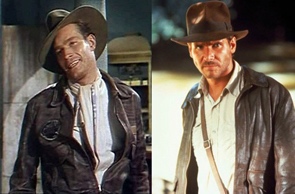While reading about Machu Picchu, I learned of an American movie that was shot there in 1954. It looked to me like any other of the flood of exotic adventure pictures that poured out of the 50s. This one’s stayed just above the brim of obscurity because it became the template for Raiders of the Lost Ark and the whole Indiana Jones series.

I wanted to see the footage of Peru and thought it might make a passable evening and take Al back to his movie usher days. I didn’t expect it to be quite so… good. I expected a B movie and got an A- instead. Well, an A–.
The bad
Let’s first acknowledge that it does meet several 1950s adventure movie expectations:
- The Hero and Heroine heroically overcome their complete lack of romance to be (I guess?) in love by Act Two.
- The production hired 500 local people in traditional garb and used them only as scenery, to provide a Noble Savage background to the action.
- Act Three was stuffed with musical numbers which bent time and space until they lasted twice as long as the rest of the movie.
The musical interruptions are especially egregious. The obvious place to insert the requisite song would have been at a Cusco nightclub before the scene shifts to the jungle. The producers instead capitalized on the current popularity of Yma Sumac, a singer better known for sideshow vocal tricks than artistry. She mugs for the camera in faux Inca rituals indistinguishable from Hollywood versions of native songs from Nepal or the South Pacific while the white cast stands around talking about how quaint it all is.
The music backing her is as bizarre as her performance. I guess it would take another 30 years for Zamfir to invade cable TV and alert the world to the soundtrack potential of the pan flute. In the meantime, the composer punctuates each phrase with Chinese gongs before wandering through Arabian harems to reach Indian snake charmers on the way to Generically Foreign.
At least Sumac, playing one of only two Inca characters with speaking roles, is Peruvian. Her brother’s an Australian actor in redface. Neither can decide whether they’re the proud descendants of a noble race or sheepish inferiors who have to beg permission from outsiders to interact with their own cultural heritage. I cringed each time they bowed and scraped to Robert Young’s lead archeologist (named, if I recall correctly, Dr. Great White Father).
All of this is to be expected from the time it was made. The real disappointment is that the exterior photography doesn’t look better. They got to shoot a movie at Machu Picchu, and it looks dark and washed-out. It should have been a CinemaScope wonder; the spectacle alone would have filled the seats. Maybe a restoration could bring it to life. Even as it is, though, it captured the last chance to see the site before it became a teeming hive of tourists. And it’s awesome to see Charlton Heston walking the same Cusco squares I walked 63 years later, and to watch a truck drive down the street where I stayed.
The good
The writing and acting are far better than I had any right to expect. The characters are smart, and their banter lively:
Hero’s friend: You ought to stay away from that crud.
Hero: I like being around Morgan, he makes me feel honest.
Hero: Any particular reason you left La Paz?
Heroine: Police. No visible means of support.
Hero: They need glasses.
Government official: Welcome, the entire city is yours.
Heroine: Thank you, I’ll take it with me when we leave.
I’ve never gotten the appeal of Charlton Heston, but he’s well cast here as Harry Steele, silver-tongued tour guide and hustler. He’s sharp, clever, and competent. For the 50s, the boldness of the sexual innuendo is startling as he schedules private services for his middle-aged customers while their husbands are napping.
Thomas Mitchell is at his best. He oozes quiet menace as the friend who smiles to your face as he slips the knife in your back.
A former President of the University of Cusco is credited as a consultant, and the script stays more or less historically accurate by not saying much about history. It just uses the Inca and the Andes as a backdrop to send the characters after a fictional solid gold MacGuffin.
There is one throwaway line that jumps out. Steele describes Machu Picchu as “An ancient city of the Incas, lost for over a thousand years…”, which would mean it was lost about 500 years before it was built.
The legacy
I sat down expecting to suffer through some dreadful melodrama to get to the location shots and instead had a great time. The cast commits and turns out a much better entertainment than its Saturday matinee needs required. With judicious use of the fast forward button in the last 45 minutes, it makes a fine picture in its own right.
Today, though, it’s remembered for what it inspired. It formed the bridge from Hiram Bingham to Indiana Jones. From the second he steps on the screen, you know Heston’s the visual inspiration for Jones. But in character, he’s closer to another lovable rogue who trades his lust for gold to reveal a heart of gold.
George Lucas knew this movie backward and forward and lifted chunks of it straight into Raiders. I don’t think I’m reading too much into initials here. When an old man sends the heroine to a cantina to hire a pilot to smuggle her out of the country because she’s being chased by an oppressive regime… It’s not a lot of parsecs from Harry Steele to Han Solo.
If you’re intrigued, you’re in luck! The whole thing is just one click away on YouTube.